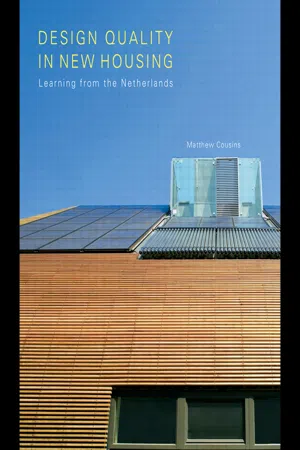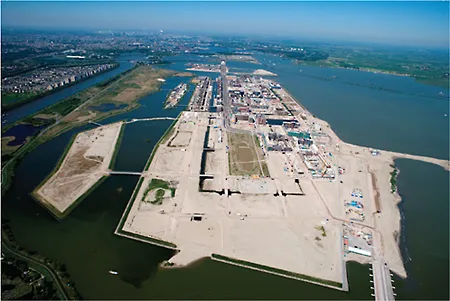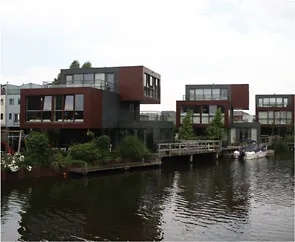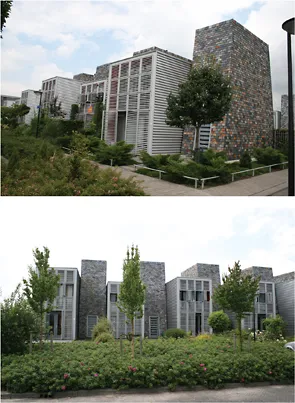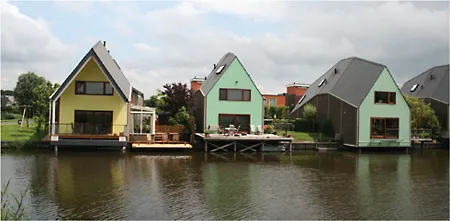chapter one
Design quality in the Netherlands
Context
The Netherlands boasts a large number of very high-quality new housing developments and has a history of well-designed and distinctive housing. The Dutch government has played a major role in the delivery of new housing and has made design quality an important part of government policy. This can be seen in the role of the government, which is anchored in the constitutional provision to promote and guarantee sufficient availability and quality of housing for its citizens; ‘the promotion of sufficient residential accommodation is a subject of concern to the government.’1 Although the Netherlands is often commended for its innovative and contemporary housing, many new houses in the Netherlands are not built to the highest quality standards. Jonathan Woodroffe, an architect working in the Netherlands, argues:
Only one per cent of what is being built here is avantgarde. There’s a huge amount which is pretty ordinary… It’s difficult to build really high quality here.2
Furthermore, not everyone in the Netherlands is of the opinion that Dutch housing demonstrates characteristics of good design quality. Many Vinex housing projects have caused controversy and been heavily criticised for their lack of services, poor design and unsustainability:
The fundamental aims of the Vinex operation are not achieved. The built fabric is not compact. The range of housing options is unbalanced. The amount of differentiation in the programme is negligible. The problem of personal transport is simply aggravated by the total car-dependence. Sustainability loses out, with minimal house dimensions and no scenarios for the future development of these dormitory suburbs.3
Due to a rising population and the demand for smaller and more spacious dwellings there is a housing shortage in the Netherlands. It is estimated that between 2010 and 2020 an additional 800,000 new dwellings will have to be built to meet demand.4 To address this housing shortage the Dutch have taken an innovative and pragmatic approach to the design and planning of new housing. As this book demonstrates, many new houses in the Netherlands have been constructed on large brownfield sites. These include the former military airport at Ypenburg, the former docks at the Eastern Harbour District, or on reclaimed land such as the artificial islands of Ijburg. Other new housing developments have been constructed on greenfield sites on farmland outside existing towns such as Vathorst and Leidsche Rijn.
Consensus culture
It has often been commented that the successful design quality of housing in the Netherlands is a result of a consensus culture. Hans Ibelings, in The Artificial Landscape: Contemporary Architecture, Urbanism, and Landscape Architecture in the Netherlands asserts that Dutch consensus has led to the protection of the citizen by the government and this in turn has led to good housing:
The task of the public administration is to provide direction in order to protect weak interests and safeguard collective values.5
Historically, there has been a strong culture of collaboration in Dutch politics known as the ‘polder-model’. This expression derives from the word polder, or reclaimed land, which describes the historical cultivation of the land from the sea. The concept of the ‘polder-model’ is one of consensus where all citizens can contribute to their environment. The Netherlands consists of twelve municipalities each with local responsibilities for areas such as the environment, spatial planning and traffic. After acquiring the land for a housing development, the municipality takes responsibility for site preparation, infrastructure and street layout. Municipalities are responsible for drawing up urban development plans of the design of new housing and choosing and appointing design teams. Municipalities also set the requirement of 70 per cent private housing and 30 per cent social housing.
New Dutch housing on the reclaimed artificial islands of Ijburg outside Amsterdam.
Innovative Dutch housing overlooking a canal in Almere.
The ‘polder model’ endorses an integrated framework, which embraces architecture, urban design and landscape design in reclaiming land, planning new housing developments and preserving the Green Heart of the Ranstad area from increasing urbanisation. Partnership models in the Netherlands between the municipality, the community and the developer have been established to provide a separation of roles to avoid confusion and conflicts of interest. There is a projectbureau, a small multidisciplinary project team, in every town that is responsible for the coordination of major housing projects. Voluntary panels of experts are established jointly by local authorities and development companies and operate as a quality control team judging the quality of design on new housing developments. The government provides indirect support for housing corporations and works with local authorities and private owners to promote good quality housing through the government’s architecture policy.
The concept of an integrated framework is also seen in a regulated planning process in which the public often plays a role in the development and quality of the built environment. The citizen has a voice and can make a direct contribution to the quality of their environment. For example, in 1985, the Spatial Planning Act on the openness of public in administration (Wet openbaarheid van bestuur) contained rules about how citizens involved in a planning application in new developments in their local area could make their opinion heard about a key decision that a public body intended to make.
Vuijste and Hooker suggest that the reason for collaboration developed in the 1960s within a liberal government and free-thinking organisational structure of public management.6 As innovative ideas and influences were imported into the Netherlands in the 1960s, Dutch culture opened up to new possibilities for experimentation. This led to the development of a highly politicised public. In turn, this led to public protests opposing large construction projects such as the city hall and opera house developments in Amsterdam. The Dutch government, further exasperated by criticism of recently completed housing projects, began to re-address its urban and architectural policy.
They fought back because the public cared that their cities were being disfigured and because the discussion about the qualities of urban space was picked up by critics and their readers. Making a collective space has always been a central part of what the Dutch did.7
The principle of consensus culture as a way of safeguarding the interests of the government is today widely criticised in the Netherlands. Collaboration also often means that projects take a long time to develop whilst waiting for decisions about government subsidies and public consultation. Peter Boelhouwer, professor of housing at Delft University, argues that developers face particular problems in gaining planning approval due to the length of time municipal authorities take to reach decisions, the lengthy negotiations with local councils, the inadequate skills of council staff and procedures associated with local plans.8 In many cases this has led to political disputes in the chain of administration as the local council has faced confrontation with government departments. The consensus system is proving unpopular, and its future is widely debated in the Dutch media:
Experimental housing by Marlies Rohmer Architects from the exhibition ‘Het Wilde Wonen’ (‘wild housing’) in Almere challenged the architect and client to come up with new, experimental solutions for building customised housing.
This polder model also accommodates radical proposals, although in practice they are often smothered in compromise, just as nearly everything here gets smothered in compromise. The Dutch could be said to have an overdeveloped craving for consensus which means not only that the proposals of architects, urban planners, and landscape architects are usually less spectacular in execution than in conception, but also that their implementation is often dogged by lengthy delays. What is lacking in the Dutch culture of consultation and negotiation is decisive-ness and promptness of action.9
Consensus culture, therefore, has been a driver of good quality design in housing but it has also experienced many political and economic problems. In theory, the consensus culture concept is an attractive model, which aims to give an equal voice to everyone through the political system. In reality, collaboration is idealistic, as economic forces shape people’s values and judgements in everyday life. The quality of housing in the Netherlands has, however, benefited from a consensus culture and this has led to the creation of excellent standards and quality control. As the new housing developments in this book demonstrate, a consensus culture has led to open attitudes towards design quality and the successful creation of new housing.
Colourful housing for the 2001 Housing Expo in Almere.
SuperDutch
Dutch housing projects have received international critical acclaim and have witnessed widely documented architectural publicity. One of the best-known books on contemporary Dutch housing is by Bart Lootsma, who classified well-designed housing as ‘SuperDutch’.10 Lootsma profiles twelve ‘radical’ design firms including the architectural practices of OMA, MVRDV and Neutelings Riedjijk, and presents the best of the Dutch innovative design projects of the 1990s. In The Arti...
